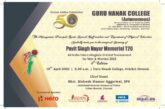COURTESY: YAHOO CRICKET, IMPACT INDEX, JAIDEEP VARMA AND JATIN THAKKAR
THE FOLLOWING COLUMN IS EXPRESSING A REAL STATE OF A LEGEND WHO ADMIRES A BILLION CRICKET LOVERS. FRANKLY SAYING EXPLAINING ABOUT 65% ONLY.LET US HOPE THE PEOPLE WHO THINK THEMSELVES THE KING OF THE GAME WOULD REALIZE THE FACT BEFORE ASKING/COMMENTING THE LEGEND TO QUIT THE GAME. IT IS A MERE JEALOUSY.
10 real reasons to remember Sachin Tendulkar in ODIs
Tendulkar’s impact is greater than what his 48 ODI centuries reveal.
By Impact Index | Yahoo! Cricket
 Tendulkar has chased down more targets than any other batsman in ODI history.
Tendulkar has chased down more targets than any other batsman in ODI history.By Jaideep Varma and Jatin Thakkar
There was a strong case for Sachin Tendulkar to call it quits after his last ODI match in Australia. His gigantic presence is quite simply not required by the Indian team any more – as what immediately follow are lesser challenges. Those can be used more constructively to build a team for the future, more pertinently – the 2015 World Cup, as it is not realistic to expect Tendulkar to be available for that.
Whether he is prudent enough to retire very soon or not (or whether he is allowed to by commercial interests determining agendas), this is not a bad time to recap his formidable, even intimidating, ODI legacy.
In conventional terms, he has all the major records – most matches played, most runs, highest tally of centuries; till recently, he also had the highest individual score. But what does it all mean? How do you combine his performances in all the parameters of batting and construct a single, holistic picture?
Impact Index tries to construct that portrait.
1. Tendulkar’s impact is greater than what his 48 ODI centuries reveal.
The real story lies in counting the IMPACT 5 performances; Tendulkar has the highest in ODI history. Impact Index measures the impact of a player in each match he plays on a scale of 0 to 5, so an IMPACT of 5 is not a common occurrence. In the history of ODI cricket, only three players have more than 50 IMPACT 5 performances in their careers – Tendulkar (74), Jayasuriya (70) and Kallis (54). Richards and Akram have 40-odd and then the cluster begins in the 30s. The remarkable thing here is that Tendulkar is largely a single skill player (despite a decent Bowling IMPACT – in fact, his bowling added to 19 of those 74 performances) and the only batsman to reach such heights.
As a pure batsman, Tendulkar is miles ahead of everybody with 55 IMPACT 5 performances; Jayasuriya is next with 38, followed by Viv Richards (29), Aravinda DeSilva (25), Ponting and Kallis (23). Azharuddin, Inzamam-ul-Haq, Jayawardene, Atapattu, Martin Crowe and Dean Jones all touch 20 too. This is different from century aggregates where Tendulkar (48) is followed by Ponting (30), Jayasuriya (28), Ganguly (22), Gibbs (21), Saeed Anwar (20), Gayle and Lara (19 each).
The list after Tendulkar changes so much because Impact Index combines functions like strike rate, pressure and others with runs tally to determine an impact. It is remarkable that Tendulkar’s IMPACT 5 performances with the bat exceed his centuries tally (in fact, many of his centuries do not touch an IMPACT of 5 as they’re in high scoring matches or against weak opposition) – it suggests that the impact of his batting goes way beyond just piling on the runs.
2. Tendulkar’s 200 is not his most landmark innings.
There are two parts to this.
One, on a series or a tournament level, it is not hard to grasp why other performances have a higher impact than his 200 – as the latter did not come in a crunch match. Unlike the top performances in his career in this context, which include the following amongst the top 5:
1) His unbeaten 117 in the first final of the CB Series against Australia in 2008. He produced a magnificent 91 in the second final too, as India won the trophy. That’s as good as big match play gets.
2) 95 vs Pakistan in Dhaka, in the first final of the Independence Cup in 1998.
3) 134 vs Australia in Sharjah in 1998.
4) 138 vs Sri Lanka in Colombo, 2009.
5) 143 vs Australia in Sharjah 1998 – the famous “sandstorm” innings, which did not win the match for India but got them into the final (so, was a big match). There are 9 other such innings before the 200 features on a “Tendulkar’s highest impact innings” list which factors in the tournament or series.
Two, even on a pure match level (without considering the series or tournament context), there are 3 performances that had a higher impact than the 200.
1) 82 not out vs Sri Lanka at Guwahati in 1997, chasing 173 in 43 overs (bizarrely, Robin Singh got the Man-of-the-Match award here for taking 5 wickets, even though he had a far lower impact).
2) 112 not out vs Sri Lanka at Sharjah, chasing 203 in 50 overs.
3) 186 not out vs New Zealand, Hyderabad, 1999. Dravid also got 153 but the Kiwis collapsed for 202. Since the opposition performance also determines impact, utterly demoralising performances like this register high. In the 200 match, South Africa did manage 248, and even from his own team, Karthik, Y Pathan and Dhoni made explosive runs, which brought down Tendulkar’s overall impact in the match. Interestingly, Tendulkar’s 89 against Pakistan at Toronto in 1996 (chasing 171 in 33 overs in not-so-easy conditions) registers almost the same impact as his 200.
3.Tendulkar’s runs tally and batting average both do not reveal his true place in ODI cricket.
Tendulkar comes 10th on a list arranged by descending batting averages in ODI history (minimum 75 matches). Amongst Indians, he is 3rd, after MS Dhoni and Virat Kohli. This is highly misleading of course, as not outs tend to skew the averages of middle-order players in ODI cricket. Runs Tally IMPACT (which measures what proportion of his team’s runs a batsman has made over his career) gives a more accurate picture, and in this measure, Tendulkar is 7th in ODI history and easily the highest Indian.
The conventional runs tally measure has him on top of the list, which of course celebrates his longevity more than anything else, as it makes no distinction between strength-of-opposition and the circumstances the runs came in.
4. Contrary to what many think, Tendulkar has absorbed pressure more times than any Indian in his ODI career.
Pressure IMPACT measures the pressure a batsman faces when wickets fall at the other end. On this count, despite being insulated somewhat as an opener (as the score is always 0-0 at the start), the bare fact is that Tendulkar absorbed pressure 64 times in his career. This came about during the 142 times he faced pressure, so he actually absorbed it 45% of the time he came under it, a very respectable percentage, especially given the long career he has had. (Dravid, who has the highest Pressure IMPACT amongst all Indians in ODI cricket, actually absorbed pressure only 39% of the time he came under it).
Internationally, only Ponting and Kallis absorbed pressure more times than Tendulkar, but they also came under it much more as they were not openers.
5. Contrary to popular assumption, Tendulkar has chased down more targets than any other batsman in ODI history.
Despite a belief in some quarters that Tendulkar plays better while setting targets than chasing them (one of the most important attributes of a top-class batsman), the fact also is that no other batsman has contributed substantially to chasing down targets as often as Tendulkar has (54 times) in all of ODI cricket. Kallis (52) and Ponting (46) follow him on that count. Amongst Indians, the gap is much more, as Azharuddin (44) and Yuvraj Singh (35) follow him.
6. Against popular perception, Tendulkar has more series/tournament-defining performances than any batsman in ODI history.
Tendulkar is joint-3rd on a list of series/tournament-defining performances – the true legacy of any cricketer is established from this. He has 10; only Jayasuriya (12) and Akram (11) are ahead of him, while Pollock (10) is level with him. That still makes him the only batsman to touch such heights. Ponting (8) and Dean Jones (7) are the batsmen who follow him on this count.
So, it is not quite true that Tendulkar hasn’t delivered in big matches for India, as has been the case made against him by some. 1998 and 2008 are the two memorable highlights in that regard.
7. Tendulkar’s Strike Rate is remarkable for someone who has scored as heavily as he has.
He has played with three generations of cricketers so his conventional strike rate of 86 tells a confused story. The standards of his time changed more than once with every generation. However, his Strike Rate IMPACT (factoring in the context of every match) is amongst the top 35 in the history of ODI cricket, which is remarkable considering how heavily he scored right through his career, and what a long career it has been (and the fact that many inconsistent pinch-hitters are ahead of him here). Amongst Indians, only
Sehwag and Kapil Dev are ahead of him, neither of whom comes even close in terms of reliability and consistency.
8. Tendulkar has played the most matches for India and yet has the lowest failure rate for batsmen.
When a batsman fails to register an impact of even 1 on the IMPACT scale, it is deemed as a failure in this system. It is remarkable that Tendulkar has the lowest failure rate amongst batsmen for India (44%) in ODI cricket. Dhoni and Sidhu run him close but they have played 190 and 131 innings (in completed matches) while Tendulkar has played a massive 433. Internationally, Tendulkar is 14th on this list, but not one of them touched even 300 innings (Gilchrist with 280 is the highest), let alone 400.
9. Tendulkar is the greatest Indian ODI batsman by a mile.
No Indian batsman comes close to Tendulkar – the amount of daylight between him and the next best dazzles the eyes – Virat Kohli, MS Dhoni, Sourav Ganguly, Navjot Sidhu, Gautam Gambhir and Md Azharuddin – all form a cluster way below him in this order, on the IMPACT list, which is rather different from the view conventional statistics provides.
10. Tendulkar is the greatest ODI batsman of his generation.
Internationally, ever since Tendulkar came into his own as an ODI batsman (1994), no one has come close to having his kind of impact in this form of the game. Three batsmen from the generation before his, however, did have a greater impact than him – Viv Richards, Dean Jones and Gordon Greenidge, in this order. There can be no doubt that Richards was the greatest batsman in this format (he tops all the major batting parameters by a distance). Dean Jones’ place in ODI cricket is scandalously forgotten today – he was a true game-changer for his generation in this format, and narrowly after Richards, the highest impact big match player in ODI history. Greenidge’s phenomenal talent, besides finding more consistent expression in this form of the game, also got the benefit of his team’s legendary bowlers giving his own batting contributions more weight in the context of the match (Richards also benefitted from this, of course, but he was a bigger occasion player and is very far ahead of everybody else anyway). When it comes to sheer quantity of runs, it’s interesting that all three (and interestingly, also Geoff Marsh) actually scored a higher proportion of runs for their teams in their respective careers than Tendulkar did over his (measured by Runs Tally IMPACT).
But of course, Tendulkar’s career has been more than double the size of each of theirs. In the end, this longevity is Tendulkar’s greatest attribute in ODI cricket history – it is what makes him go up all these IMPACT batting lists too. That, combined with his consistency and the many batting parameters on which he has delivered suggests that he has been the most complete batsman in ODI cricket. More than anything else, this is what defines Sachin Tendulkar’s greatness in this format.
One can only hope that now, an artificially induced longevity (more through commercial interests than cricketing motivation) at the end of his career does not take away the sheen off what he has accomplished. Sadly, there is danger of that happening.
LET US ALL GIVE THE HONOR BY GIVING THE LEGEND TO CHOOSE HIS TIME





